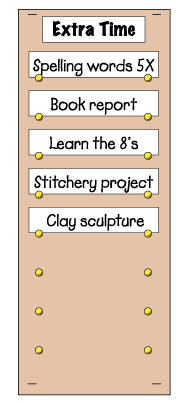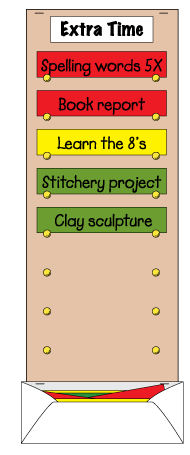
E.T. Chart
As you can see in the example to the right, the E.T. Chart lists  activities for students to engage in when they've finished their regularly assigned material. (E.T. stands for Extra Time or Educational Time.) I've seen these kinds of charts in classrooms for years on end; nonetheless, when I tried my own, I experienced a bit of difficulty.
activities for students to engage in when they've finished their regularly assigned material. (E.T. stands for Extra Time or Educational Time.) I've seen these kinds of charts in classrooms for years on end; nonetheless, when I tried my own, I experienced a bit of difficulty.
The challenge I faced had to do with the allure of the shortcut. Kids were always looking for them. That's part of being a kid.
But part of my job, as the responsible, well-intentioned adult, was to keep them all on that Straight and Narrow Path to Success.
Let's use Calvin as an example of a student who often gets off the path by taking a shortcut.
Calvin has just finished his literature lesson. After turning in his paper and marking off his number, he returns to his seat.
Calvin
Thinking:
----Now what.----
Looking around room:
----Oh, yeah, The E.T. Chart.----
Scanning the list of choices:
----Hmmmm...spelling words...no...book report...no...learn the 8's...heck, no...stitchery...nope...CLAY SCULPTURE!----
He somehow overlooks Write Spelling Words 5 Times Each, Finish Book Report, Learn the 8's, and the stitchery seatcover project. He jumps over all of them and lands on "clay sculpture."
I guess I shouldn't be too surprised. Working with clay is fun. And besides, if Calvin had taken care of his regular class business, I'd want him to choose a fun activity. I just wanted to ensure that he was completing his other assignments before he embarked on a fun fest.
![]()

With all of those thoughts in mind, I decided to rework the time-honored Extra Time Chart. Not for the mere sake of reinventing the wheel, mind you, but a rethinking generated by necessity.
The change I made to the E.T. Chart had to do with the kind of paper I used for the activity headers. I wrote some activities on red construction paper, some on yellow paper, and some of them on green.
Red Paper
This was an activity Calvin needed to complete before moving on to any other choices.
Note: If there were two red headers, as shown here, you could establish your own priority list.
Yellow Paper
Although the activities written on yellow paper might not be something Calvin could complete--after all, he could study the 8's multiplication facts for a week--they represent items that needed his attention.
Green Paper
When Calvin had finished all of the activities written on red paper and maybe worked on the yellow ones for fifteen minutes or so, he would then be free to choose from the optional activities written on green paper.
Using different colored paper to denote different priorities was a simple change, nonetheless, the E.T. Chart has worked a heck of a lot better since I switched to colored headers.
![]()
You could accomplish the same goal--getting students to use their extra time more wisely--with Must Do and May Do Lists. The required activities would be listed on the Must Do List while the bonus activities would be listed on the May Do List.
My only quibble with this idea is the language used. "Must Do" just sounds a bit too dictatorial. A little too much of the Old School culture of obedience and not enough emphasis on independence and self-direction.
Or maybe that's just how I see it.

